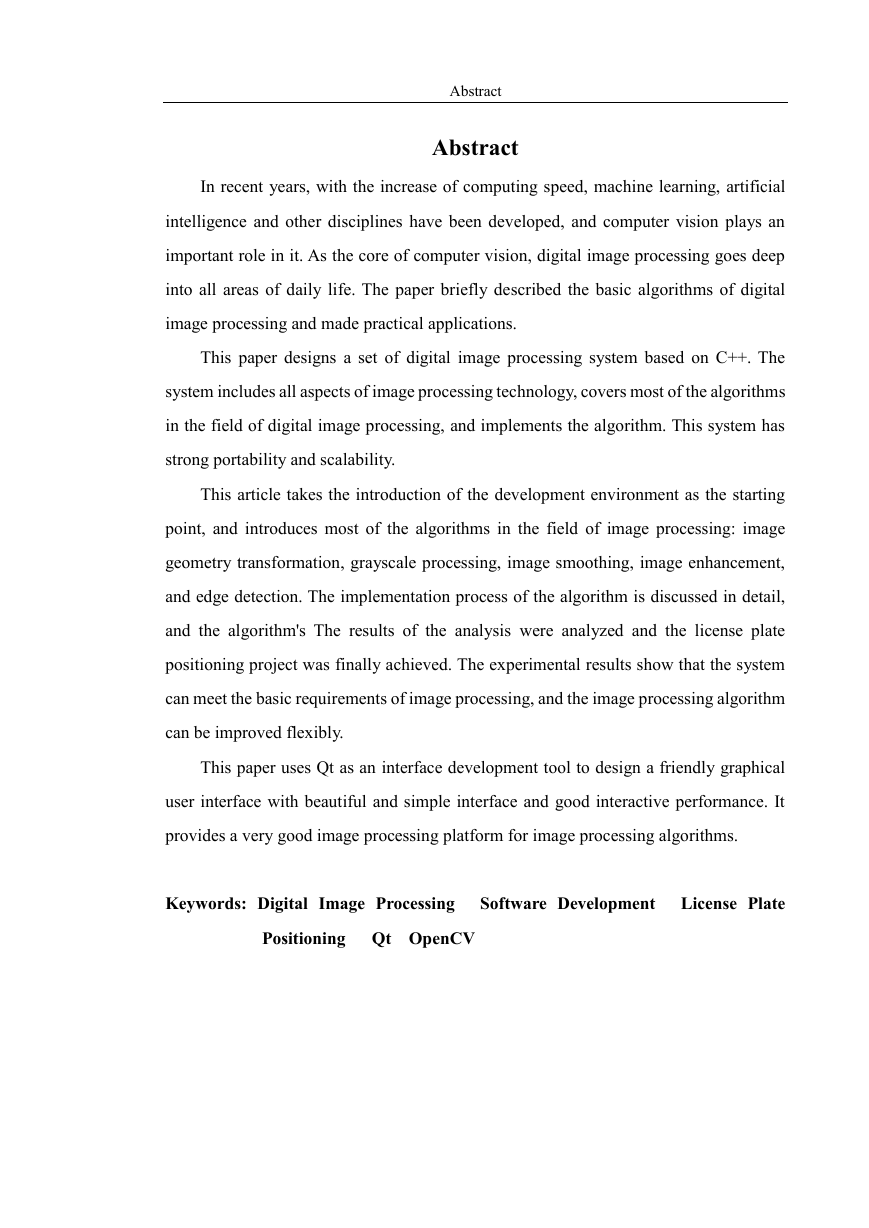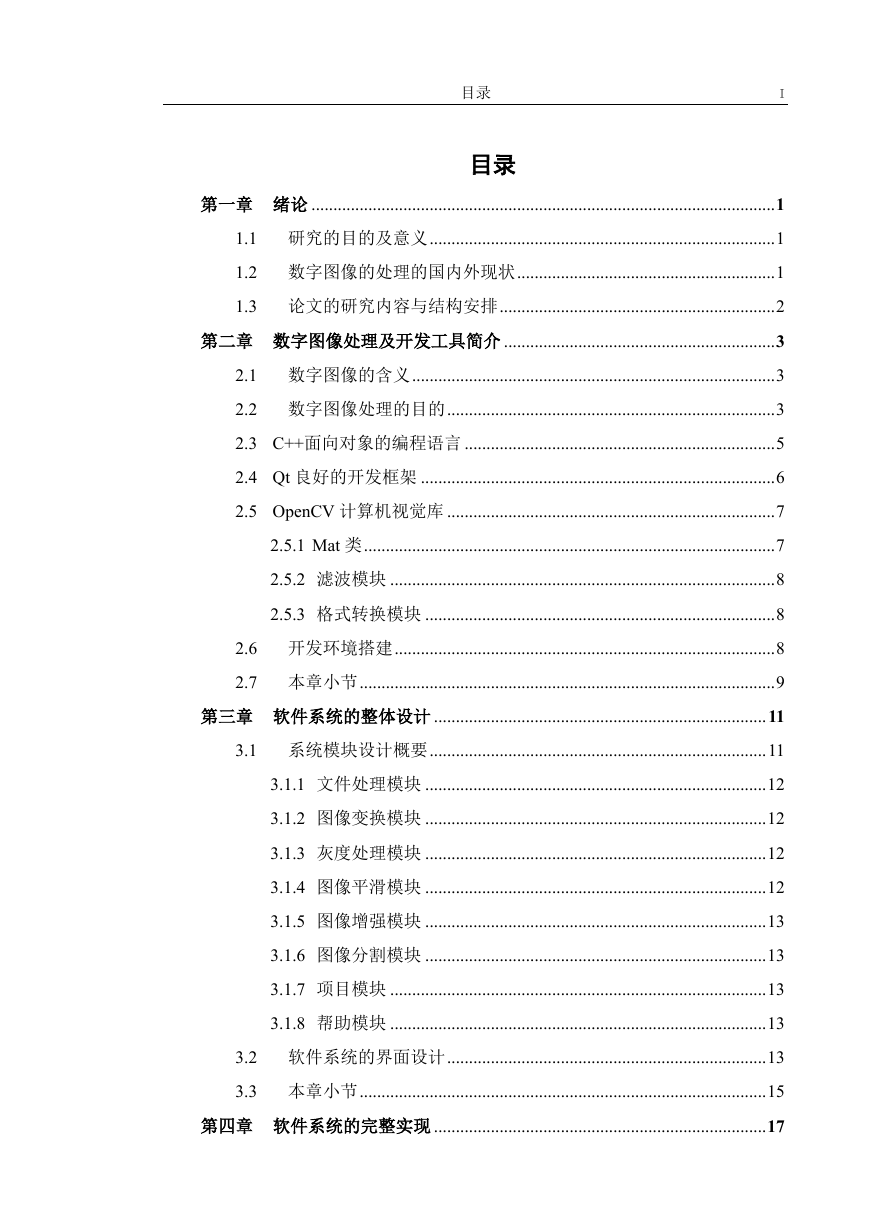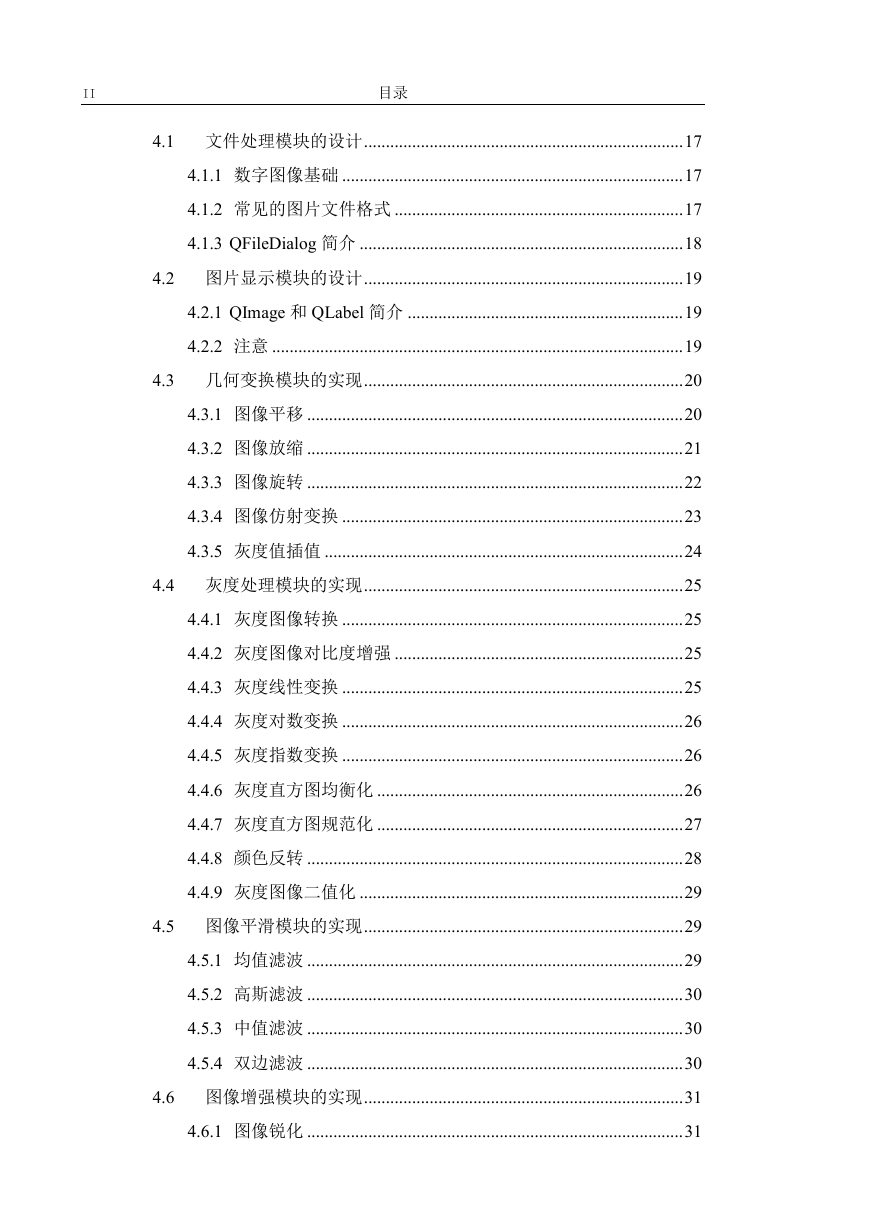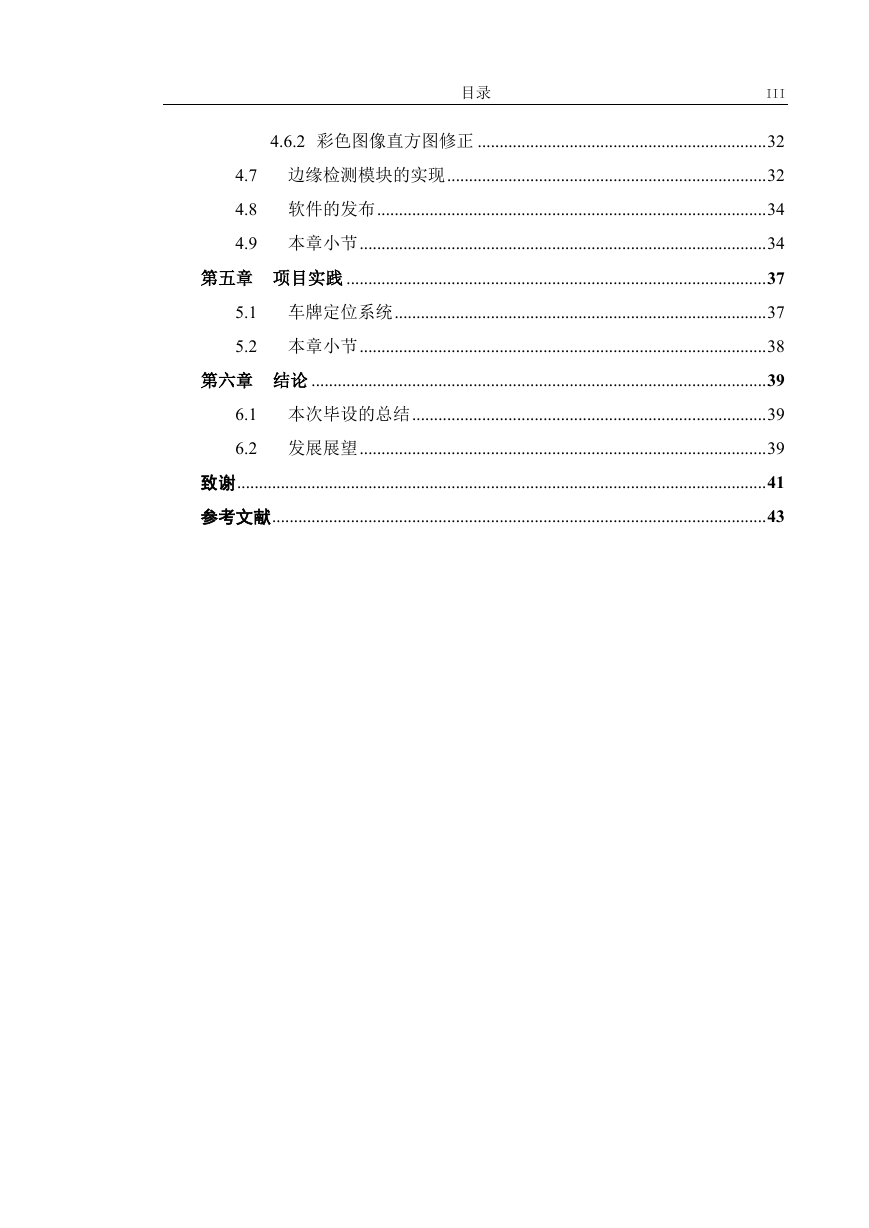摘要
摘要
近年来,随着计算机运算速度的提升,机器学习、人工智能等学科得以发展,
而计算机视觉在其中占据着至关重要的作用。作为计算机视觉的核心,数字图像处
理深入到日常生活的各个领域。论文简述了数字图像处理的基本算法,并做出实际
应用。
本文设计了一套基于 C++的数字图像处理系统,系统中包括图像处理技术的
各个方面,涵盖了数字图像处理领域的大部分算法,并对算法进行了实现。本系统
具有很强的可移植性和扩展性。
本文以开发环境的介绍为切入点,相继介绍了图像处理领域的大部分算法:图
像几何变换、灰度处理、图像平滑、图像增强、边缘检测,详细论述了算法的实现
过程,并对算法的处理结果进行了分析,最终实现车牌定位项目。实验结果表明系
统能够满足图像处理的基本要求,可以灵活的对图像处理算法进行改进。
本文以 Qt 作为界面开发工具,设计了一套友好的图形用户界面,界面美观简
洁,交互性能良好,为图像向处理算法的研究人员提供了一个非常好的图像处理平
台。
关键词:数字图像处理 软件开发 车牌定位 Qt OpenCV
�
�
Abstract
Abstract
In recent years, with the increase of computing speed, machine learning, artificial
intelligence and other disciplines have been developed, and computer vision plays an
important role in it. As the core of computer vision, digital image processing goes deep
into all areas of daily life. The paper briefly described the basic algorithms of digital
image processing and made practical applications.
This paper designs a set of digital image processing system based on C++. The
system includes all aspects of image processing technology, covers most of the algorithms
in the field of digital image processing, and implements the algorithm. This system has
strong portability and scalability.
This article takes the introduction of the development environment as the starting
point, and introduces most of the algorithms in the field of image processing: image
geometry transformation, grayscale processing, image smoothing, image enhancement,
and edge detection. The implementation process of the algorithm is discussed in detail,
and the algorithm's The results of the analysis were analyzed and the license plate
positioning project was finally achieved. The experimental results show that the system
can meet the basic requirements of image processing, and the image processing algorithm
can be improved flexibly.
This paper uses Qt as an interface development tool to design a friendly graphical
user interface with beautiful and simple interface and good interactive performance. It
provides a very good image processing platform for image processing algorithms.
Keywords: Digital Image Processing Software Development License Plate
Positioning Qt OpenCV
�
�
目录
目录
I
第一章 绪论 .......................................................................................................... 1
1.1 研究的目的及意义 ............................................................................... 1
1.2 数字图像的处理的国内外现状 ........................................................... 1
1.3 论文的研究内容与结构安排 ............................................................... 2
第二章 数字图像处理及开发工具简介 .............................................................. 3
2.1 数字图像的含义 ................................................................................... 3
2.2 数字图像处理的目的 ........................................................................... 3
2.3 C++面向对象的编程语言 ....................................................................... 5
2.4 Qt 良好的开发框架 ................................................................................. 6
2.5 OpenCV 计算机视觉库 ........................................................................... 7
2.5.1 Mat 类 .............................................................................................. 7
2.5.2 滤波模块 ........................................................................................ 8
2.5.3 格式转换模块 ................................................................................ 8
2.6 开发环境搭建 ....................................................................................... 8
2.7 本章小节 ............................................................................................... 9
第三章 软件系统的整体设计 ............................................................................ 11
3.1 系统模块设计概要 ............................................................................. 11
3.1.1 文件处理模块 .............................................................................. 12
3.1.2 图像变换模块 .............................................................................. 12
3.1.3 灰度处理模块 .............................................................................. 12
3.1.4 图像平滑模块 .............................................................................. 12
3.1.5 图像增强模块 .............................................................................. 13
3.1.6 图像分割模块 .............................................................................. 13
3.1.7 项目模块 ...................................................................................... 13
3.1.8 帮助模块 ...................................................................................... 13
3.2 软件系统的界面设计 ......................................................................... 13
3.3 本章小节 ............................................................................................. 15
第四章 软件系统的完整实现 ............................................................................ 17
�
II
目录
4.1 文件处理模块的设计 ......................................................................... 17
4.1.1 数字图像基础 .............................................................................. 17
4.1.2 常见的图片文件格式 .................................................................. 17
4.1.3 QFileDialog 简介 .......................................................................... 18
4.2 图片显示模块的设计 ......................................................................... 19
4.2.1 QImage 和 QLabel 简介 ............................................................... 19
4.2.2 注意 .............................................................................................. 19
4.3 几何变换模块的实现 ......................................................................... 20
4.3.1 图像平移 ...................................................................................... 20
4.3.2 图像放缩 ...................................................................................... 21
4.3.3 图像旋转 ...................................................................................... 22
4.3.4 图像仿射变换 .............................................................................. 23
4.3.5 灰度值插值 .................................................................................. 24
4.4 灰度处理模块的实现 ......................................................................... 25
4.4.1 灰度图像转换 .............................................................................. 25
4.4.2 灰度图像对比度增强 .................................................................. 25
4.4.3 灰度线性变换 .............................................................................. 25
4.4.4 灰度对数变换 .............................................................................. 26
4.4.5 灰度指数变换 .............................................................................. 26
4.4.6 灰度直方图均衡化 ...................................................................... 26
4.4.7 灰度直方图规范化 ...................................................................... 27
4.4.8 颜色反转 ...................................................................................... 28
4.4.9 灰度图像二值化 .......................................................................... 29
4.5 图像平滑模块的实现 ......................................................................... 29
4.5.1 均值滤波 ...................................................................................... 29
4.5.2 高斯滤波 ...................................................................................... 30
4.5.3 中值滤波 ...................................................................................... 30
4.5.4 双边滤波 ...................................................................................... 30
4.6 图像增强模块的实现 ......................................................................... 31
4.6.1 图像锐化 ...................................................................................... 31
�
目录
III
4.6.2 彩色图像直方图修正 .................................................................. 32
4.7 边缘检测模块的实现 ......................................................................... 32
4.8 软件的发布 ......................................................................................... 34
4.9 本章小节 ............................................................................................. 34
第五章 项目实践 ................................................................................................ 37
5.1 车牌定位系统 ..................................................................................... 37
5.2 本章小节 ............................................................................................. 38
第六章 结论 ........................................................................................................ 39
6.1 本次毕设的总结 ................................................................................. 39
6.2 发展展望 ............................................................................................. 39
致谢 ......................................................................................................................... 41
参考文献 ................................................................................................................. 43
Equation Chapter (Next) Section 1
�
�
















 2023年江西萍乡中考道德与法治真题及答案.doc
2023年江西萍乡中考道德与法治真题及答案.doc 2012年重庆南川中考生物真题及答案.doc
2012年重庆南川中考生物真题及答案.doc 2013年江西师范大学地理学综合及文艺理论基础考研真题.doc
2013年江西师范大学地理学综合及文艺理论基础考研真题.doc 2020年四川甘孜小升初语文真题及答案I卷.doc
2020年四川甘孜小升初语文真题及答案I卷.doc 2020年注册岩土工程师专业基础考试真题及答案.doc
2020年注册岩土工程师专业基础考试真题及答案.doc 2023-2024学年福建省厦门市九年级上学期数学月考试题及答案.doc
2023-2024学年福建省厦门市九年级上学期数学月考试题及答案.doc 2021-2022学年辽宁省沈阳市大东区九年级上学期语文期末试题及答案.doc
2021-2022学年辽宁省沈阳市大东区九年级上学期语文期末试题及答案.doc 2022-2023学年北京东城区初三第一学期物理期末试卷及答案.doc
2022-2023学年北京东城区初三第一学期物理期末试卷及答案.doc 2018上半年江西教师资格初中地理学科知识与教学能力真题及答案.doc
2018上半年江西教师资格初中地理学科知识与教学能力真题及答案.doc 2012年河北国家公务员申论考试真题及答案-省级.doc
2012年河北国家公务员申论考试真题及答案-省级.doc 2020-2021学年江苏省扬州市江都区邵樊片九年级上学期数学第一次质量检测试题及答案.doc
2020-2021学年江苏省扬州市江都区邵樊片九年级上学期数学第一次质量检测试题及答案.doc 2022下半年黑龙江教师资格证中学综合素质真题及答案.doc
2022下半年黑龙江教师资格证中学综合素质真题及答案.doc